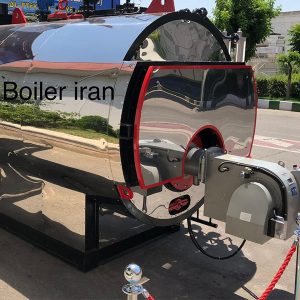Description
Principles of design and manufacture of hot oil boilers
The hot oil boiler must be designed and manufactured in such a way that the heat transfer takes place in three complete heat passes between the oil and the combustion gases. Increasing the heat transfer level in a hot oil heater will increase energy use and reduce fuel consumption.
In addition, in hot oil boilers, the heat must be transferred evenly to the heating oil that is circulating and circulating in the coil heat coils. Any uneven and excessive heat or stopping of oil movement in the path of the heat coil will cause the oil temperature to rise and if the oil temperature rises above its maximum allowable operating temperature, it will quickly cause the oil to oxidize and form sludge or coke in the system. The oil becomes acidic, which in practice will disable the system in a short time.
It should be noted that due to the high temperature in hot oil boilers, observance of safety principles in its design and construction is very important and any disregard for its technical complexity and safety principles can cause personal injury and financial losses. Be abundant. Unfortunately, no national and mandatory standards for hot oil heaters have been developed so far. Therefore, reputable manufacturers usually design and produce it using the technical principles provided in the German standard number DIN4754.
What is a hot oil boiler?
Hot Oil Boiler, also known as Thermal Oil Boiler, is used as a device to transfer heat from one fluid to another. In this device, high temperatures can be achieved at low pressures. Therefore, due to this issue and increasing the level of heat transfer, more energy can be used, but at the same time, fuel consumption in this process is reduced. Water and steam are known as heat carriers in heating systems, and because they require adequate pressure at high temperatures, they are an important and vital option.
The boiler or hot oil boiler uses a special oil that is used as a substitute for water and steam. For this reason, it will be possible to reach 300 ° C at atmospheric pressure. Of course, it is necessary to point out that due to the dangers of fire, explosion of oil gases and depreciation of the device, the construction of a hot oil boiler will have temperature restrictions. In addition, the heat in this device must move evenly and be transferred to the oil. Otherwise, any uniform motion will increase the temperature of the oil, the disadvantages of which can be oxidation of the oil, the formation of sludge and acidification of the oil, and in a short time, the hot oil boiler will fail.
Mechanical equipment of hot oil boiler
In the design of hot oil boiler, several sections have been used, which are divided into main and sub-sections. In the following, we will refer to each of them in the relevant group:
The main parts of a hot oil boiler
Body
networks
Furnace or firebox
Fire hoses or smoke pipes
Chassis
Hot oil boiler sub-components
Torch (boiler)
central power Board
Pressure switches
Safety valve
Electric pump
The main valve
Level control
Water taps
Drain valve
Ventilation valve
Doors
Manometer
Hook
Chimney flange
Blower chamber
Electric eye or photocell
Platform and ladder
Water level control electrode
Manhole valves
Sampling valve
Flame Inspection Valve
The burner is one of the main components of a hot oil boiler, but it is separate from the boiler and is installed on the boiler after construction. Hot oil boiler burner consists of the following parts:
The shell of the burner, which is responsible for converting fuel into energy.
The electric motor is used to rotate the impeller.
Fan (butterfly), this part is used to direct air into the furnace.
Electrode or spark plug, used to ignite.
Tawzel is used to spray fuel as a powder.
Wire, the job of this department is to conduct high voltage electricity.
High pressure transformer
Air valve and related arm
Application of hot oil boiler and its types
The use and design of hot oil boilers is very wide and is used in various industries. These industries include the following:
Chemical manufacturing industries, including: solvents, adhesives, resins, petroleum products, paints, reactors, polymerization machines and autoclave heating.
Textile, dyeing and production machinery industries.
Wood Industry
Food industry
Paper industry
Bitumen production industry
In general, it can be said that the use of hot oil boilers is increasing today in various industries and its use is preferred to hot oil boilers. Because the hot oil boiler produces more heat than the hot oil boiler, the heat control in the boiler is easier and more convenient. Therefore, hot oil boilers are used for applications that require high temperatures and indirect control.
Advantages of hot oil boilers
Working at high temperatures and low pressures
More safety and security
No need for water purifiers
Easy to use and reduced maintenance options
No heat reduction
No freezing
No sedimentation
No corrosion
No possibility of explosion if the instructions are followed
Easy installation
No need for a lot of space
Optimal and high quality of materials used in it
Less noise compared to boilers
Less time to achieve the desired temperature compared to boilers
No need to perform purification and pre-purification operations
Small volume with the ability to install in small spaces
High reliability in body design and interior components
Observance of strength b



Reviews
There are no reviews yet.